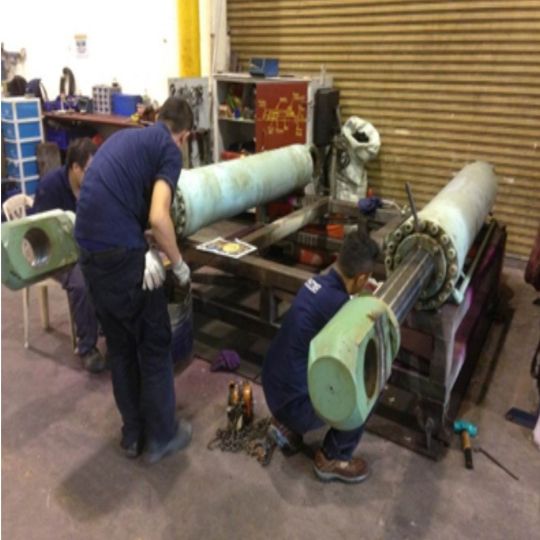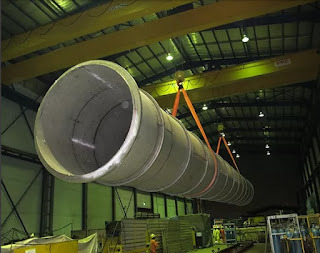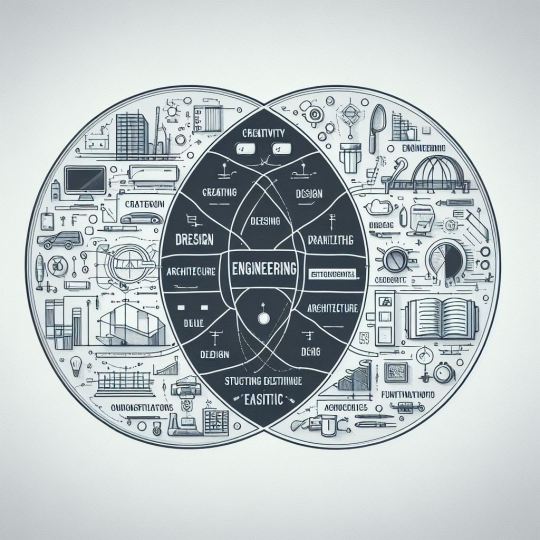#integrated engineering solutions
Explore tagged Tumblr posts
Text
Progressive Advancement of Surface Engineering

Developed with intent to protect the material surfaces from weathering actions, corrosion, surface degradations and so on, the technique of surface protection, (which otherwise in common language is referred to as surface engineering), is the simple modifying, of a metal surface or any other surface. Enhancing the material surface properties methodically, surface engineering has an important role to play in the protection of material surfaces that are vulnerable to external factors. The main concepts behind surface engineering are modification of the surface without affecting the material composition, modification of surface involving compositional adjustment and the direct application of coatings of suitable materials like pants or alloys on to the surface, where in no physical or chemical changes or alterations are done. While there are other processes of protecting the surface materials by transformation like hardening, surface texturing, carburizing, nitriding, anodizing, electroplating, hard-facing, thermal spraying and vapour deposition, all the techniques however aim at the protection of the material surface. Although surface engineering has been widely applied in various sectors along-side there has been quite bit of research activities that has been carried out in order to improvise it. Setting up of the surface engineering research institute, bringing out the international journal of surface engineering, has given scope for developing of the sector rapidly in recent years. In the recent two to three decades, surface engineering has virtually gone through swift developing stages, from the traditional single coating technology to composite surface coating technology and nano surface technology.
The growth of nano science and its technology, use of nano-materials and nano-technologies have been made use in surface engineering. In the recent time surface engineering techniques are being utilised in sports good manufacturing. The capability of creating diverse and collective surface properties, the technique efficiently meets the challenging design requirements needed in the advanced sports merchandises. Surface engineering technologies thus has initiated application in the sports equipment sector and has undoubtedly created a very strong impact in the sport equipment designing and development.
All put together, surface engineering is such a technology that targets at the adjustment of microstructure, composition of the surface region, in order to improvise the surface-dependent industrial properties of the material and its surface. However this requires a lot of technical expertise and enormous amount of knowledge and technical know-how. Organizations like wwg engineering have been in this sector since long. They possess the required skill sets, technical expertise, dedication and above all the grit to satisfy the clients by giving them the best services. Wwg engineering offers all the compositional surface engineering technology services in the most economical and convenient ways.
To Learn About More Details On Engineering Service Company Please Come And Visit Our Website..!
#engineering service company#engineering service provider#engineering solutions#surface engineering technology#integrated engineering solutions#machine refurbishment services#hydraulic cylinder specialist#hydraulic equipment services#hydraulic cylinder repair services#hydraulic cylinder singapore
0 notes
Text
Surface Engineering Technology and its significance
Technologies that are intended to transform the properties of metallic or non-metallic constituents, especially on the surface for either decorative or functional resolves are in general called surface engineering. The main motive behind the development of this technology is to reduce or eliminate corrosion, increase wear resistance and lengthen the component life. A precise and well-calculated process makes the surface more visually attractive and enhances the durability of the material. The most common examples of surface engineering is electroplating, applying metal coatings, aluminium anodising, electro polishing and so on.
These processes apart there are some simple but effective methods that are carried out to protect and lengthen the life of metal surfaces. The metal is heated in presence of specific gases which modify the surface structure and to some extent the properties of a substance which results in softening or hardening and a considerable change in composition to produce unique surface properties that are sought after. Methods like galvanizing, tinning, metal spraying and enamelling are also followed to create a comparatively dense layer on the surface of the material thereby protecting the metal against deterioration.

Surface engineering is no doubt that makes use of a variety of surface coating and modification methods in order to produce diverse properties which act as a protective aid to the material. This technology is employed in sectors like the manufacture of advanced engineering tools and products that enhance the ability to add value to products. Surface engineering technology has also found a place in several application sectors like the equipment industry wherein they have created a strong influence in terms of design modifications and cost-effective benefits.
WWG Engineering Pte Ltd was started to basically provide engineering services with a speciality in surface engineering expertise, especially in thermal spray aluminium coating, hard chromeplating and so on. With its exceptional skills in Integrated Engineering Solutions, the company also provides first-class engineering solutions in reference to hydraulic cylinders and other rotating equipment. WWG Engineering Pte Ltd also provides expert services in components refurbishing, repairing and re-manufacturing as well.
#Surface engineering technology#mechanical engineering services#thermal spray aluminium coating#hydraulic cylinders#integrated engineering solutions
0 notes
Text
Role of Renewable Energy Systems in Sustainable Urbanization
Sustainable urban development is crucial as cities expand and energy demands grow. Renewable energy systems, such as solar, wind, and hydropower, offer cleaner alternatives to fossil fuels, helping reduce carbon footprints and combat climate change. MKCE focuses on educating students through hands-on projects, equipping them to design and implement efficient energy systems. These systems provide economic benefits, enhance energy security, and improve public health by reducing air pollution. Despite challenges like high initial costs and infrastructure gaps, innovations like smart grids and energy storage are transforming urban energy management. MKCE prepares students to tackle these challenges and contribute to global sustainability goals. The adoption of renewable energy is essential for achieving a cleaner, healthier future. Through education and innovation, MKCE plays a key role in shaping future leaders in renewable energy. The integration of renewable energy is vital for building resilient and sustainable cities. Together, we can transition to a greener, more sustainable urban future. To Know More : https://mkce.ac.in/blog/the-role-of-renewable-energy-systems-in-sustainable-urban-development/
#best engineering college in karur#private college#mkce college#best engineering college#top 10 colleges in tn#mkce#libary#engineering college in karur#engineering college#mkce.ac.in#mkce Sustainable Urban Development#mkce Renewable Energy Systems#mkce Clean Energy Solutions#mkce Solar Energy Integration#mkce Energy Storage Innovations#Carbon Neutral Cities#mkce Green Urban Infrastructure#Fossil Fuel Alternatives#mkce Smart Grids Technology#mkce why mkce#mkce college achievement#mkce college admissions#mkce management#Smart Grids Technology#Energy Efficiency Solutions#Urban Resilience Strategies#Decentralized Energy Systems#Public Health and Clean Energy#Wind Energy Adoption#Global Renewable Energy Trends
0 notes
Text
Choosing a Data Engineering Consultant: Your Complete Guide: Find the perfect data engineering consultant with our guide. Explore critical factors like flexibility, compliance, and ongoing support.
#data engineering consultant#data engineering services#data consulting partner#data analytics consultant#data engineering expert#data-driven business strategy#choosing data consultant#business intelligence solutions#scalable data engineering#data integration consultant#data pipeline optimization
0 notes
Text
0 notes
Text
Corporate Travel Management | Corporate Travel Solutions
Corporate Travel Management Software Company
In today's fast-paced business landscape, global connectivity is critical for expansion and operations. Thus, corporate travel has become an essential component of many business operations. Companies are increasingly turning to Corporate Travel Management Solutions (CTMS) to effectively deal with the complexities of business travel. These solutions go beyond traditional travel booking platforms, providing comprehensive tools to simplify the complete process. It also ensures cost-effectiveness and other necessary compliances.

FlightsLogic is an award-winning global provider of innovative and cost-effective travel solutions for corporate, events, leisure, loyalty, and business travelers. It includes features like invoice generation, multiple payment options, and 24x7 support to help travel agents and managers make the best bookings. Our corporate travel software solutions automate document management and include pre-designed templates for all major travel document types. This feature allows you to increase the speed of your operations, avoid human errors, and track legislative compliance. Our corporate travel management solutions will help your business thrive.
FlightsLogic offers adaptable corporate travel management solutions that enable easy booking, an exceptional travel experience, and seamless trip management. Our cutting-edge technology-based solutions and services improve every aspect of corporate travel. We value complete transparency and incorporate it into all of our services. We help corporations select from a diverse inventory at competitive prices. Corporations can expand their reach by integrating it with leading GDSs.
Our industry-leading travel solutions make business travel simple and convenient. From simple booking to clear travel policies and simple invoicing, our powerful features make corporate travel less stressful. Corporates can use FlightsLogic to ensure policy adherence and generate detailed reports for increased ROI.
FlightsLogic, designed for modern organizations, streamlines corporate travel with an all-in-one travel management solution that includes intelligent travel booking, price assurance, traveler services, and more. Our all-in-one travel booking system allows you to book flights, hotels, and rental cars at the lowest possible prices in minutes. Gain total visibility into your travel spending with seamless integration.
For more information, please visit our website: https://www.flightslogic.com/corporate-travel-management-solutions.php
#corporate travel solution#best corporate travel agency#travelbookingengine#b2b travel portal#b2b travel software#flight api#travel software development#flight booking websites#travel agent system#b2c booking engine#flight api integration#flight booking system
0 notes
Text
"The Crucial Role of Industrial Control Integrators: Driving Efficiency and Innovation in Modern Industry"
The Essential Role of an Industrial Control Integrator in Modern Industry
In today’s fast-paced industrial environment, the expertise of an Industrial Control Integrator has become indispensable. These professionals or companies specialize in designing, implementing, and maintaining complex control systems that are critical for optimizing industrial processes. This blog delves into the pivotal role of an Industrial Control Integrator, explaining their key responsibilities and the impact they have on industrial efficiency.
What is an Industrial Control Integrator?
An Industrial Control Integrator is a specialized expert or firm responsible for creating and managing control systems that automate and regulate industrial machinery and processes. These control systems encompass both hardware and software components, which work together to enhance performance, increase reliability, and streamline operations.
Core Responsibilities of an Industrial Control Integrator
Control System Design and Engineering:
Needs Analysis: The integrator begins with a comprehensive assessment of the client’s specific requirements. This involves understanding their industrial processes and defining the desired outcomes.
Custom System Design: Based on the assessment, the integrator designs a bespoke control system, selecting the appropriate sensors, controllers, and communication protocols to meet the client’s needs.
Integration and Installation:
Hardware Setup: The integrator manages the installation of essential components such as Programmable Logic Controllers (PLCs), Human-Machine Interfaces (HMIs), and other field instruments.
Software Configuration: They also configure the software that governs the control system, ensuring seamless communication between hardware and other operational systems.
Testing and Commissioning:
System Testing: Before full deployment, the integrator conducts rigorous testing to identify and rectify any issues, simulating real-world conditions to verify system performance.
Commissioning: Once testing is complete, the integrator supervises the final commissioning process, making any necessary adjustments to ensure optimal functionality.
Training and Ongoing Support:
Staff Training: Integrators provide training for the client’s personnel, equipping them with the knowledge to operate and maintain the new system effectively.
Continued Support: They offer ongoing maintenance and support services to resolve any issues and ensure the system continues to operate smoothly.
Why Industrial Control Integrators are Vital
Boosting Efficiency:
Industrial Control Integrators streamline processes by automating operations, which reduces manual input and enhances precision. This leads to improved productivity and reduced operational costs.
Enhancing Safety:
Integrators implement advanced control systems that monitor conditions in real time, increasing workplace safety by triggering alarms or shutdowns when necessary.
Ensuring Reliability:
By designing systems with redundancy and fail-safes, integrators help minimize downtime, which is crucial for meeting production targets and maintaining product quality.
Facilitating Scalability:
As businesses expand, their control systems must adapt. Integrators create flexible solutions that can be easily scaled or upgraded to meet growing demands.
Incorporating Emerging Technologies:
With the rise of Industry 4.0, integrating new technologies such as the Internet of Things (IoT), advanced analytics, and Artificial Intelligence (AI) is becoming increasingly important. Control integrators are key to incorporating these innovations into existing systems.
The Future of Industrial Control Integration
The field of industrial control integration is continuously evolving, driven by technological advancements and shifting industry needs. Future trends include:
AI and Machine Learning Integration: Enhancing predictive maintenance and process optimization.
IoT Integration: Enabling more detailed data collection and real-time analytics.
Enhanced Cybersecurity: Addressing the increasing need for robust security measures to protect industrial control systems from cyber threats.
Conclusion
Industrial Control Integrators are essential in ensuring the efficiency, reliability, and safety of modern industrial processes. Their expertise in designing, implementing, and maintaining control systems is crucial for optimizing operations and keeping pace with technological advancements. For businesses looking to upgrade or implement control systems, partnering with a skilled Industrial Control Integrator can be the key to achieving greater efficiency and performance.
#Industrial Control Integrator#Industrial Automation#Control Systems Engineering#Programmable Logic Controllers (PLCs)#Human-Machine Interfaces (HMIs)#Industrial Process Optimization#Automation Solutions#System Integration#Industrial Efficiency#Operational Reliability#Advanced Control Systems#Industry 4.0#Internet of Things (IoT)#Artificial Intelligence (AI) in Industry#Predictive Maintenance#Industrial Cybersecurity#Control System Design#Industrial Technology Trends#Engineering and Integration Services#Manufacturing Automation
0 notes
Text
Vehicle Body and Gateway Solutions | Body electronics
KPIT delivers Vehicle Body & Gateway solutions, SDV Programs, Body electronics, Body System Engineering, Body Features Validation, HPC, Zonal ECUs & more. KPIT provides comprehensive solutions for Vehicle Body & Gateway from concept development to maintenance for current & next generation programs
#Body electronics#Body System Engineering Services#Application Development & Integration Services#Body Features Validation Service#SDV programs#vehicle body and gateway solutions#Body & Gateway software development#Body Gateway Module
0 notes
Text
Innovating Pipeline Rehabilitation: Pipe CIPP Lining Engineering Design Services as per ASTM F1216
In the dynamic world of plumbing and pipe rehabilitation, Cured-In-Place Pipe (CIPP) lining stands as a testament to the industry's progress and innovation. Pioneering a non-invasive, cost-effective, and efficient approach to pipeline repair, CIPP lining engineering design services have carved a significant niche in the industry. Adherence to the ASTM F1216 standard, set by the American Society for Testing and Materials, has further cemented the integrity and reliability of these services.
CIPP Lining: A Brief Overview
CIPP lining is a trenchless rehabilitation method that effectively repairs existing pipelines without the need for excavation. This process involves inserting and running a felt lining into a pre-existing pipe that is impregnated with a specially formulated resin. This resin is then cured, essentially creating a "pipe within a pipe."
The CIPP method addresses a wide array of issues, such as leaks, corrosion, root intrusion, and age-related wear and tear, without disrupting the landscape or the daily activities of businesses or households.
CIPP Lining Engineering Design Services
CIPP lining engineering design services employ advanced technology and innovative engineering principles to create effective, long-lasting solutions for pipeline problems. These services are critical to accurately assessing the damage, designing the CIPP liner, implementing the solution, and ensuring successful pipeline rehabilitation.
These engineering design services consist of various steps, such as:
Inspection: Before any design work can begin, the pipe's condition needs to be assessed using closed-circuit television (CCTV) inspection and other technologies. This inspection enables engineers to evaluate the damage extent and pinpoint its location.
Design: Based on the inspection, engineers design the CIPP liner considering factors such as pipe diameter, length, material, operating conditions, and the type and extent of damage.
Installation: This step involves inserting the designed liner into the damaged pipe and curing it using hot water, steam, or UV light.
Post-installation Inspection: The final step involves inspecting the rehabilitated pipe to ensure the CIPP liner is correctly installed and functioning as expected.
The Role of ASTM F1216
The ASTM F1216 - "Standard Practice for Rehabilitation of Existing Pipelines and Conduits by the Inversion and Curing of a Resin-Impregnated Tube," is a globally recognized standard that guides the CIPP lining process. It prescribes the material requirements, resin preparation, inversion process, curing method, and testing techniques for CIPP lining.
Adherence to this standard ensures that the CIPP lining engineering design services meet the necessary quality and safety standards. It also guarantees the end product's durability, structural integrity, and optimal functionality.
Benefits of CIPP Lining Engineering Design Services
CIPP lining engineering design services offer numerous benefits, such as:
Durability: CIPP linings have a lifespan of up to 50 years, making them a long-lasting solution.
Non-disruptive: Being a trenchless method, CIPP lining causes minimal disruption to daily activities and avoids damaging landscapes or structures.
Versatility: CIPP lining is suitable for various pipe materials and diameters, making it a versatile solution.
Cost-effective: CIPP lining eliminates the need for excavation and extensive manual labor, significantly reducing costs.
Efficiency: The entire CIPP lining process can often be completed in a day, making it an efficient solution for pipeline rehabilitation.
Among the many engineering firms providing CIPP lining design services, Little P.Eng. Engineering has distinguished itself as a leader. Leveraging a combination of industry expertise, innovation, and adherence to the ASTM F1216 standard, the firm has been able to provide high-quality, efficient, and reliable pipeline rehabilitation services.
Firstly, the firm's deep-rooted understanding of pipeline systems is undeniable. They have a team of dedicated professional engineers (P.Eng.) who bring a wealth of knowledge and experience to the table. Their engineers understand the intricacies of different pipeline materials, their response to various environmental conditions, and potential failure modes.
Their specialization in CIPP lining, a modern, trenchless pipeline rehabilitation method, has allowed them to handle a broad range of pipeline issues effectively. Whether it's handling minor leaks, major corrosion issues, or extensive root intrusion, their team is adept at designing and implementing the appropriate CIPP lining solution.
Adherence to the ASTM F1216 standard has been a cornerstone of Little P.Eng. Engineering's approach to CIPP lining engineering services. This commitment ensures that the resin preparation, inversion process, curing methods, and testing techniques used meet the highest quality and safety standards. It also guarantees that the resulting CIPP lining possesses the durability, structural integrity, and functionality necessary for long-term pipeline performance.
Moreover, Little P.Eng. Engineering is known for its innovative approach. They harness the latest technologies and engineering principles to improve the effectiveness and efficiency of their CIPP lining design services. This includes using state-of-the-art CCTV technology for initial pipeline inspection and advanced curing methods to ensure optimal resin curing.
Lastly, the firm's dedication to customer satisfaction sets them apart. They understand that every client has unique needs and circumstances, and they strive to provide tailored solutions that are both effective and cost-efficient. They also prioritize transparent communication, ensuring their clients understand every aspect of the rehabilitation process.
In conclusion, Little P.Eng. Engineering's deep expertise, innovative approach, and commitment to customer satisfaction make them a preferred choice for CIPP lining engineering design services. Their rigorous adherence to ASTM F1216 further assures clients that they are receiving high-quality, safe, and durable pipeline rehabilitation solutions. The combination of these factors positions Little P.Eng. Engineering as a reliable partner in the industry, capable of effectively addressing a wide array of pipeline challenges.
Conclusion
In the realm of plumbing and pipeline rehabilitation, CIPP lining engineering design services as per ASTM F1216 have proven to be a game-changer. By providing a non-invasive, cost-effective, and efficient solution to pipe repair, they have redefined traditional methods. As the industry continues to innovate, the importance of these services and the ASTM F1216 standard's adherence will only grow, paving the way for a future where pipeline problems are no longer a headache but a manageable, efficient process.
Read More:
Innovating Pipeline Rehabilitation: Pipe CIPP Lining Engineering Design Services as per ASTM F1216
Pipeline Rehabilitation Engineering Design Services as per ASTM F1216 Using CIPP and PVC
Little P.Eng. Engineering For CIPP Liner Design As Per ASTM F1216 Using Finite Element Method
Revolutionizing Pipe Rehabilitation: Little P.Eng. Engineering's Mastery of CIPP Liner Design via Finite Element Method in Accordance with ASTM F1216
Tags:
Meena Rezkallah
Little P.Eng. Engineering
ASTM F1216
Professional Engineers
Pipe Rehabilitation
CIPP Lining
Engineering Design Services
Trenchless Technology
Pipeline Repair
Cured-In-Place Pipe
Resin-Impregnated Tube
Plumbing Industry Innovation
Pipe Lining Solutions
Pipeline Inspection
Durability and Structural Integrity
Cost-Effective Pipeline Solutions
Engineering Services
Pipe Rehabilitation
Located in Calgary, Alberta; Vancouver, BC; Toronto, Ontario; Edmonton, Alberta; Houston Texas; Torrance, California; El Segundo, CA; Manhattan Beach, CA; Concord, CA; We offer our engineering consultancy services across Canada and United States. Meena Rezkallah.
#Meena Rezkallah#Little P.Eng. Engineering#ASTM F1216#Professional Engineers#Pipe Rehabilitation#CIPP Lining#Engineering Design Services#Trenchless Technology#Pipeline Repair#Cured-In-Place Pipe#Resin-Impregnated Tube#Plumbing Industry Innovation#Pipe Lining Solutions#Pipeline Inspection#Durability and Structural Integrity#Cost-Effective Pipeline Solutions
0 notes
Text
#UNICEF UK#Job Vacancy#Data Engineer#London#Permanent#Part home/Part office#£52#000 per annum#Enterprise Data Platform#Data Ingestion Pipelines#Data Models#UUK Data Strategy#Information Team#Data Solutions#Data Integrations#Complex Data Migrations#Code Development#Datawarehouse Environment#Snowflake#Apply Online#Closing Date: 7 March 2024#First Round Interview: 5 April 2024#Second Round Interview: 6 June 2024#Excellent Pay#Benefits#Flexible Working#Annual Leave#Pension#Discounts#Wellbeing Tools
0 notes
Text
"Discover tailored digital marketing solutions for your business growth. Our comprehensive services encompass SEO, PPC, social media management, content creation, and more. Gain a competitive edge with strategic campaigns and measurable results. Explore our expertise today."
#Digital marketing solutions#Professional Seo Agency#Top Ranked SEO Company#SEO consultant services#local search engine optimization service#digital marketing#seo services#ppc services#api integration services#Organic SEO Services
0 notes
Text
Surface Engineering : Conceiving Surface Properties of Materials

Collectively comprising of numerous surface coating and surface modification techniques and processes surface engineering collectively is a wide ranging and analytic technology. The technology basically is capable of creating a diverse set of surface properties to make the challenging requirements of users and is considered as the most suitable solution. The basic reason for the modification of the surface structure of the material surface is to protect it from atmospheric, chemical, or any other accidental actions, which may otherwise destroy the entire material. While there has been various methods and technologies that have been used to carry out this particular action with advancement of science and technology the methods procedures and processes have also been upgraded along with the use of sophisticated devices and equipment.
The protection of material surfaces was initially carried by employing very simple methods like coating metal surfaces with agents like paint, red oxide or chromium. While paint and red oxide application was done manually using a brush or roller, chromium has to be done by a chemical method known as electrolysis, where, in the material, which had to be coated with chromium would be used as one of the electrodes. Spray painting was an upgrade of simple painting technique, where the paint would be brought to lower consistency and would be sprayed on the surface using a spray gun. Here the application of paint on the surface would give a smooth finish, and totally eliminate streaks and craters, that would otherwise be created with a brush or a roller. However, this method also had its disadvantages. The first and foremost one was the chipping of paint, which would occur if the paint could not adhere to the metal surface or other material surface.
So, in other words this method was not a permanent method of protecting the material surface. In the recent years surface engineering with an increasing demand has also updated into advanced scientific methods like plasma, treatment, and so on. While there are cases where in surface engineering methodologies are employed to protect the surface of material likewise, there are cases where in properties of metallic and non-metallic components or surfaces are altered for decorative purposes also. Another very commonly used method to protect metal surfaces that are used to make cabinets, shelves and similar items is that of powder coating. In powder coating, a spray of fine quality powder of the desired colour is sprayed onto the surface thereby creating a protective layer. Engineering specialists like WWG who are the pioneers surface engineering techniques are constantly looking up for highly sought after technologies in this field, by combining integrated engineering services offering diverse facilities in mechanical engineering services, water, treatment, power generation marine and petro chemical sectors.
To Learn About More Details On Surface Engineering Technology Please Come And Visit Our Website..!
#surface engineering technology#engineering service company#engineering service provider#engineering solutions#integrated engineering solutions#hydraulic cylinder repair services#hydraulic cylinder singapore#hydraulic equipment services#machine refurbishment services#hydraulic cylinder specialist
0 notes
Text
Special Integrated Engineering Design Solutions by Mun Siong Engineering
Mun Siong Engineering offers specialised integrated engineering design solutions. Among our many services are:

Customised Solutions: Engineered designs that are specifically adapted to your project's needs.
Multidisciplinary Approach: Combining different engineering specialties to provide comprehensive solutions.
Innovative Designs: Making the most of state-of-the-art techniques and cutting-edge technology to achieve desired results.
Efficiency and Optimisation: To optimise efficiency, operations should be streamlined.
Sustainability: Including eco-friendly technologies and sustainable methods in design solutions.
Collaborative Partnerships: Maintaining close communication with clients to guarantee project goals and vision are aligned.
Mun Siong Engineering exceeds expectations by providing comprehensive engineering design solutions with an emphasis on innovation, efficiency, and sustainability. We are dedicated to provide premium and affordable solutions from inception to conclusion to satisfy the changing demands of our clients in Singapore and beyond.
For additional information:
Fax: +65 6862 0218
Phone: +65 6411 6570
Email: [email protected]
0 notes
Text
Unveiling the Distinctions: Architecture vs. Engineering
Introduction: In the vast realm of design and construction, two fields stand out as pillars of creativity and innovation: architecture and engineering. While they often collaborate closely, each discipline carries a unique set of responsibilities, skills, and perspectives. This article aims to delve into the fundamental differences between architecture and engineering, shedding light on the…

View On WordPress
#aesthetic structures#Architectural Design#Architectural Innovation#architecture and engineering collaboration#building codes compliance#building construction#built environment#collaborative design#construction phase oversight#cultural sensitivity in architecture#design development#energy-efficient systems#engineering services#environmentally friendly solutions#interdisciplinary design#precision in engineering#problem-solving in design#spatial planning#structural integrity#sustainable design#sustainable materials#technical expertise in engineering#visual appeal in architecture.
0 notes
Text
Value of Integrated Engineering Design Solutions | Mun Siong Engineering
Mun Siong Engineering demonstrates a dedication to comprehensive project development and customer success by offering unmatched value through its Integrated Engineering Design Solutions.
All-encompassing Method: Mun Siong Engineering's integrated engineering design takes a holistic approach, integrating several engineering disciplines smoothly to guarantee a well-coordinated and effective project lifecycle.
Enhanced Productivity: The main goal is to maximise cost-effectiveness and efficiency by simplifying the design process and reducing redundancies to complete projects on schedule and within the allocated budget.
Technology and Innovation: Mun Siong Engineering employs cutting-edge technology to deliver clients cutting-edge solutions that comply with industry standards by incorporating innovation into every facet of design.
Customer-focused solutions: Delivering client-centric solutions that are suited to particular demands is the main goal. Mun Siong Engineering ensures alignment with objectives and operational parameters by comprehending and incorporating each client's specific requirements into the integrated engineering design.
Risk Reduction and Adherence: Compliance and risk reduction are given top priority. Early in the project lifecycle, the integrated engineering design services identify possible risks and put methods in place to manage them, all the while maintaining strict adherence to industry norms and standards.
In conclusion, Mun Siong Engineering's Integrated Engineering Design Solutions are a testament to the company's position as a pioneer in all-encompassing industrial solutions. They provide intrinsic value to projects and embody a synergy of efficiency, creativity, and client focus.
For additional information:
Fax: +65 6862 0218
Phone: +65 6411 6570
Email: [email protected]
Website: https://www.mun-siong.com/

0 notes
Text
Top Greenhouse Manufacturers: Innovations and Designs
STERLING ARCH PRODUCTS stands as a premier greenhouse manufacturer, situated at Plot-81 Ecotech VI in Greater Noida. With a commitment to quality and innovation, Sterling Arch specializes in crafting cutting-edge greenhouses that epitomize durability, functionality, and sustainability. Their designs integrate modern technology with eco-conscious practices, offering solutions for various agricultural and horticultural needs. Each structure is meticulously engineered to optimize natural light, climate control, and space utilization. Sterling Arch Products' dedication to superior craftsmanship and their strategic location in Greater Noida makes them a frontrunner in the industry, catering to diverse clientele seeking reliable, state-of-the-art greenhouse solutions.
#situated at Plot-81 Ecotech VI in Greater Noida. With a commitment to quality and innovation#Sterling Arch specializes in crafting cutting-edge greenhouses that epitomize durability#functionality#and sustainability. Their designs integrate modern technology with eco-conscious practices#offering solutions for various agricultural and horticultural needs. Each structure is meticulously engineered to optimize natural light#climate control#catering to diverse clientele seeking reliable#state-of-the-art greenhouse solutions.
0 notes